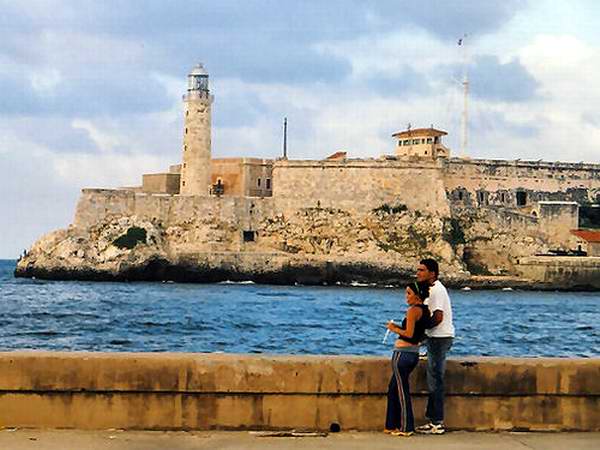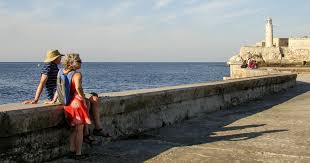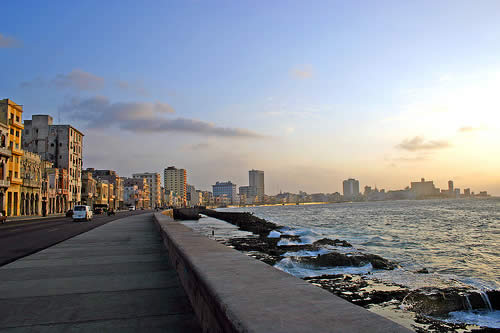
BREVE HISTORIA DEL MALECON HABANERO “EL MURO DE LOS SUSPIROS”. PHOTOS.
El kilométrico Malecón de la Habana se extiende a lo largo de todo el litoral norte de la ciudad, sirviendo tanto de mirador, como de asiento para enamorados, de base para pescadores o como muro de suspiros, de lamentos o de inspiración para almas bohemias.
Su función original es, tal y como se puede esperar de construcciones costeras de este tipo, servir de rompeolas y proteger a la ciudad de las inclemencias meteorológicas, ya que precisamente fue creado con el propósito de evitar las frecuentes inundaciones que afectaban a los barrios del norte, especialmente durante el invierno.
Así que sí, el malecón habanero es técnicamente un muro, un extenso dique que circunda la Bahía de La Habana por ocho (casi nueve) largos kilómetros, pero es mucho más que eso. Su altura lo hace accesible al transeúnte de a pie en busca de descanso acompañado de un relajante paisaje marítimo. Es así como a lo largo de su centenaria historia, este muro se ha convertido en el banco más popular de la capital cubana y como tal es como más se le conoce.
Fue durante el gobierno interventor norteamericano que el Malecón Habanero se comenzó su construcción en 1901, en su primer tramo, que comprendía desde el Castillo de la Punta hasta la calle Crespo, o sea, unos 500 metros de largo, con una exuberante arboleda y numerosas luminarias.
El objetivo principal de su construcción fue para la defensa de la capital contra las aguas y los llamados ¨ Nortes ¨, pero en realidad, sirvió mucho más para paseos nocturnos de los habaneros, para los enamorados y sobre todo para pescadores particulares.
La historia del Malecón habanero
Para celebrar la inauguración de los primeros 500 metros de malecón, el gobierno de Estados Unidos construyó una bonita glorieta en la esquina del Paseo del Prado que, según los arquitectos de la época, fue la primera obra realizada de hormigón armado –con cabillas- en nuestro país. Frente a la glorieta, donde cada domingo una banda de música tocaba melodías cubanas, se levantó el hotel Miramar, muy de moda durante los primeros quince años de república y donde por primera vez los camareros vistieron de smoking, chaleco con abotonadura dorada y sin bigotes.
Los siguientes gobiernos cubanos continuaron la extensión del primer tramo del Malecón. Fue en 1923 que pudo llegar hasta la desembocadura del río Almendares y a la altura de las calles K y L del Vedado, donde se construyó la Embajada de Estados Unidos, el famoso Parque Deportivo José Martí y más allá el Hotel Rosita de Hornedo, hoy llamado Sierra Maestra.
En la actualidad, el Malecón habanero sigue siendo el lugar más concurrido de los cubanos, sobre todo por los cubanos de a pie que carecen de medios económicos para frecuentar una discoteca cuyo pago es en divisas, o un hotel, todos exclusivos para extranjeros.
Además, es conocido por todos que el Malecón es fuente de ingresos para familias muy pobres, que durante las horas nocturnas realizan la pesca como medio de subsistencia.
Espectáculos realmente deprimentes pueden verse también en el Malecón habanero, cuando la policía casi de forma permanente vigila a las mujeres y hombres jóvenes que andan a la caza de turistas para ejercer el oficio más antiguo de la humanidad.
A pesar de verse casi en ruinas las antiguas y valiosas edificaciones que van de forma paralela al Malecón, tras ser detenido el desarrollo arquitectónico a partir del triunfo del régimen castrista, aún es muy bello el litoral de la capital. Tanto los cubanos como aquellos que nos visitan, no dejan de visitar y admirar uno de los lugares más hermosos de La Habana.

BRIEF HISTORY OF THE HAVANA MALECON “THE WALL OF SUSPIROS”. PHOTOS.
The kilometer-long Malecón of Havana extends along the entire northern coast of the city, serving as a viewing point, as a seat for lovers, as a base for fishermen or as a wall of sighs, of laments or of inspiration for bohemian souls.
Its original function is, as can be expected from coastal constructions of this type, to serve as a breakwater and protect the city from inclement weather, since it was precisely created with the purpose of avoiding the frequent floods that affected the northern neighborhoods, especially during the winter.
So yes, the Havana Malecón is technically a wall, an extensive dike that surrounds the Bay of Havana for eight (almost nine) long kilometers, but it is much more than that. Its height makes it accessible to pedestrians looking for rest accompanied by a relaxing maritime landscape. This is how, throughout its century-old history, this wall has become the most popular bank in the Cuban capital and is best known as such.
It was during the American intervention government that the Malecón Habanero began its construction in 1901, in its first section, which ran from the Castillo de la Punta to Crespo Street, that is, about 500 meters long, with a lush grove and numerous lights.
The main objective of its construction was to defend the capital against the waters and the so-called “Nortes”, but in reality, it served much more for night walks by Havana residents, for lovers and especially for private fishermen.
The history of the Malecón Habanero
To celebrate the inauguration of the first 500 meters of the seawall, the United States government built a beautiful gazebo on the corner of Paseo del Prado which, according to the architects of the time, was the first work made of reinforced concrete – with rebar – in our country. Facing the roundabout, where every Sunday a band played Cuban melodies, the Miramar Hotel was built, very fashionable during the first fifteen years of the republic and where for the first time the waiters dressed in tuxedos, vests with gold buttons and without moustaches.
The following Cuban governments continued the extension of the first section of the Malecón. It was in 1923 that it was able to reach the mouth of the Almendares River and the height of K and L streets in Vedado, where the United States Embassy was built, the famous José Martí Sports Park and beyond that the Rosita de Hornedo Hotel, today called Sierra Maestra.
Today, the Havana Malecón continues to be the most popular place for Cubans, especially for ordinary Cubans who lack the financial means to frequent a discotheque where payment is made in foreign currency, or a hotel, all of which are exclusive to foreigners.
Furthermore, it is well known that the Malecón is a source of income for very poor families, who fish at night as a means of subsistence.
Truly depressing spectacles can also be seen on the Malecón in Havana, when the police almost constantly watch over the young men and women who hunt for tourists to practice the oldest profession of humanity.
Despite the fact that the old and valuable buildings that run parallel to the Malecón are almost in ruins, after architectural development was halted following the triumph of the Castro regime, the capital’s coastline is still very beautiful. Both Cubans and those who visit us do not fail to visit and admire one of the most beautiful places in Havana.

Agencies/Tania Díaz / Extractos/ Excerpts/ Internet Photos/ Arnoldo Varona.
wwww.thecubanhistory.com
THE CUBAN HISTORY, HOLLYWOOD.



